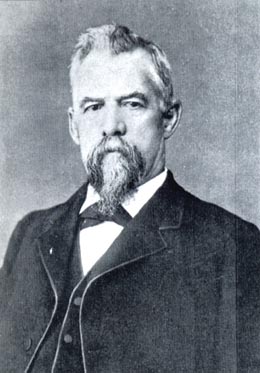Morgan Morgans came to Washington Territory in 1885 as local superintendent for the Black Diamond Coal Mining Company. He would serve in that capacity until his retirement in 1904. This People's History by William Kombol, manager of the Palmer Coking Coal Company in Black Diamond, recounts Morgans's life and his near-complete authority over the town of Black Diamond.
From Wales to Washington State
Morgan Morgans was born in Wales and came to the United States with his parents in 1846 at the age of 16. Like many Welsh immigrants, they first settled in the anthracite coalfields of Pennsylvania. He moved to California as a young man and in the early 1850s discovered the Eureka quartz mine while working for the D.O. Mills-Alvinza Hayward combination, an association he would be employed with for more than 50 years.
Morgans (his surname is sometimes given as Morgan) arrived at Nortonville in Contra Costa, California, in 1868 and began his long association with the Black Diamond Coal Mining Company, which had grown out of his work for Mills and Hayward. California coal was of an inferior quality, and the Black Diamond Coal Mining Company's management was always in search of better coal for their San Francisco markets.
In the spring of 1880 the company sent an expeditionary party under the leadership of Victor Tull to find a new seam of coal. Tull discovered an abundance of high-quality coal outcroppings along the Green River in Washington Territory in July of that year. B. B. Jones, a company superintendent and coal expert, was soon brought to the scene.
Building a Coal Town
With plenty of money at its disposal, the Black Diamond Coal Mining Company pushed development work along rapidly. By January 1882 a crew of men were building houses, cutting trails to the river, and opening the new seam of coal. By April 1882 coal samples had been sent to San Francisco; the tests proved so successful that on June 7, 1882, Pierre B. Cornwall, president of the company, and Morgans, by then the superintendent of mines, left San Francisco by steamer, arriving in Seattle less than three days later. The following day, Cornwall and Morgans set out by wagon to visit their company's new mine, traveling first to Renton and then to Black Diamond by horseback, as there were no roads into the area.
Following their visit, an extension of the Columbia & Puget Sound Railroad was surveyed from Renton to Black Diamond. The new line was constructed over the next three years, with the tracks extending two miles farther east to the nearby coal mining town of Franklin. The railroad to Black Diamond was completed on December 12, 1884, and the California coal mines closed later than month.
Superintendent of Mines and a Town
Morgan Morgans was sent to King County in 1885 as general superintendent of the Black Diamond mines. He brought his family, and the miners and most of Nortonville's families followed him to work the new mines. Black Diamond's coal was vastly superior to the coal that had been mined back in Nortonville.
In almost every respect -- economic, social, and physical -- the new town of Black Diamond was shaped by the demands of the coal industry and its management. The land on which most of the homes were built remained the property of the company. As mine superintendent, Morgans determined who could buy land, to whom they could sell, and at what price. Morgans donated the town cemetery; controlled liquor, electricity, and medical care; dictated mine holidays; and authorized political rallies. He attended the State constitutional convention and was an original signer of the Washington State Constitution. He famously declared that one church was sufficient for all to attend -- the Congregational Church, which became Black Diamond's first.
Morgans remained in charge of the Black Diamond mines until the company's holdings were acquired by the Pacific Coast Coal Company in May 1904. By that time Morgans was a wealthy man and he retired from active work.
He suffered from asthma and moved to Spokane for relief. On December 9, 1905, Morgan Morgans passed away from kidney disease at the age of 75 at his daughter's home in Spokane. In honor of his passing the mines were closed and a special train was provided with free fare for the people from Black Diamond to attend his funeral in Seattle.

